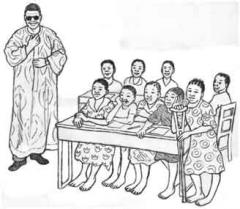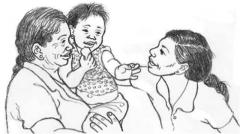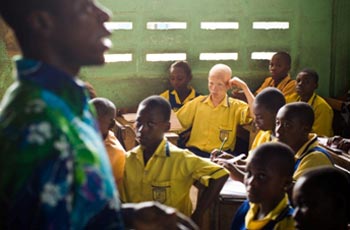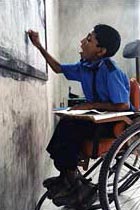Your progress
0%
Here are some of the key ideas about CBR and primary education.
Use your mouse or keyboard to expand each of the headings below.
It is the responsibility of the whole community to promote and support inclusion, and local primary schools provide a key opportunity and environment in which to demonstrate this. CBR needs to work in collaboration with schools, families, people with disabilities, and community leaders.
Some examples of how different people and groups can be involved include:
Parents know their own child best and can provide very helpful information to teachers
Teachers can help parents support learning at home
The district education office promotes and supports inclusion of all towards sustainability
The health and social sectors enhance the possibility of inclusion of all through their involvement and communication with other stakeholders
In addition, itinerant or travelling teachers can create linkages, share specific skills such as teaching Braille and travel to schools to provide advice, resources and support for students with disabilities, their teachers and their parents
Learn about how a young boy with cerebral palsy and his mother became accepted and supported by the community through a whole-community approach


Yuri lives with his mother and sisters in the Andes Mountains, Peru. Yuri has cerebral palsy and is unable to walk. He wanted to go to primary school like his sisters, but he faced a number of barriers:
CBR personnel focused on empowering Yuri’s mother, who then mobilized the community to build a path from her house to the road. CBR also provided a hand tricycle for Yuri and prepared the teachers with disability awareness and training. Yuri began attending the primary school, and was received with a welcome party from the other students.

A whole-school approach ensures that all those involved in or with a connection to a school will work together to raise awareness about disability, identify and remove barriers to facilitate the inclusion of disabled children in the local school. The people who may be involved include head teachers, class teachers, administrators, caretakers, parents and children with and without disabilities
Learn about how a community in Cape Verde made their school accessible.


“Good Practices in Inclusive Education of Children with Disabilities in Cape Verde” was a study undertaken by Handicap International. It was carried out on the Islands of Santiago, São Vicente, Fogo and Brava and focuses on pre-school, primary and secondary schools.
This study demonstrates that it is possible, with the existing resources, to conduct good practices in Inclusive Education in Cape Verde, which could be replicated in other educational settings.
There is still much to be done, but together we have a responsibility to create the conditions so that every child has access to education.
Watch the video here: https://www.youtube.com/watch?v=iuT1_y_zvPY
Usage attributions will go here once we hear from Priscille about its details

Many people and programmes may focus only on academic learning. It is just as important for children to learn how to relate and live together with others and be open, helpful and respectful of others.
Children who experience difficulty in learning academic skills may still benefit from being included socially in the local school environment. This also prepares all children to become members of an inclusive society.
All children are different and learn in different ways. Schools can respond to this diversity by ensuring that curricula, teaching methods and environments are flexible and accommodating to all. A flexible system requires making adjustments for everyone, not just one particular group. A school that is good for children with disabilities will be one that is good for all children.
Responding to diversity also means recognizing that children with disabilities are very different from each other, even if they have similar impairments. For example, people with visual impairment may access the curriculum in different ways: one person may find tape recordings useful; another may find Braille more helpful; while still another may make use of apps on a smart phone. Some children with a hearing impairment may learn well through lip-reading, whilst others may use sign language as their cultural language and need others who know and use it for teaching support.
Research suggests that accessibility reduces the cost of inclusion overall.
The school environment needs to be physically accessible for all children, with specific attention given to ensuring that toilets are accessible for children with disabilities. Schools can also pay attention to their appearance and atmosphere to ensure that the environment is welcoming for all. A clean school with appropriate sanitation and clean water facilities, colourful displays on the walls, and positive attitudes and behaviour from children, teachers and other staff all contribute to a welcoming environment.

The quality of what happens in schools is as important as access. A learner-centred or child-centred approach means that all processes and structures in a school are centred on supporting each child to learn and participate.
Learner-centred also means “age-appropriate”. Sometimes a child with a disability may not be identified early enough to begin basic education at the same time as his/her peers. A child with intellectual impairment may be older but have a relatively young mental age. Each situation may differ; in some circumstances, it may be best to support the child with the additional help or supplementary learning required to allow him or her to be with similar-age peers, while in other situations, it may best for the child to join a class with younger classmates. In all circumstances, it is important to respect the child’s actual age and work with teachers, parents and the community to support his or her best interests.
The two important principles on the use of resources and support are:
Use of local resources: Most resources and support needed to help children learn are not ”special”. Local resources (material, financial or human) should be used.
Provision of access to specialist support: For some children with disabilities, specialist input is required to facilitate their inclusion. Specialist skills, support or equipment may be needed for learning Braille, or for learning to use augmentative and alternative forms of communication to speech. Some of these may include signboards, charts, gestures, electronic devices, pictures, apps on smart phones or tablets
For more information, see the Health module: Assistive devices